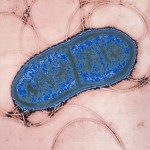Présentation
Bacteria exchange and recombine DNA to accelerate their evolution and adapt to new stress. Their evolvability is illustrated by the rapid emergence of multi resistant bacteria after the introduction of antibiotics. The most powerful driver of antibioresistance is the integron system. Integrons are able to stockpile, shuffle, express adaptive functions embedded in cassettes. Integrons can be carried by conjugative plasmids making them highly mobile. These so-called Mobile Integrons (MIs) have disseminated in many environmental niches and are now widespread in hospitals worldwide. MIs are relatively small and contain no more than eight cassettes. Importantly, MIs are only the tip of the iceberg since much larger sedentary and chromosomal integrons (SCI) are present in the genomes of 15% of sequenced bacteria. Some SCIs were shown to harbor more than 200 cassettes. SCIs constitute a huge cassette reservoir for MIs and the remarkable adaptive success of the integron system is partly due to this intricate connection between SCIs and MIs.
Twenty years after their discovery, SCIs remain enigmatic genetic structures and there is still substantial knowledge gaps on their biological roles. They contain an almost infinite variety of functions extending far beyond antibioresistance and likely linked to bacterial key adaptive functions such as pathogenicity, virulence and diverse attack/defense strategies to compete and thrive in different niches, and managing interactions with bacteriophages and bacteria. The first objective of this proposal will be to determine the cassette functions of the Vibrio choleraechromosomal integron. We also ignore how such genetic structures can accumulate so many silent cassettes and still be maintained in bacteria.The second objective will be to better understand how bacteria maintain such gigantic structures and such wealth of functions to take advantage on them while limiting their metabolic and genetic burden. Our recent in silico analyses revealed that most of SCIs (83%) have a specific orientation relative to the direction of replication. Interestingly, the few SCIs found in the other orientation had smaller arrays of cassettes than the others. We hypothesize that the SCI orientation is key to maintain large SCI structures in genomes by limiting excessive cassette excision. We will challenge this hypothesis by studying the impact of the V. cholerae SCI orientation on cassette excision rate. Highlighting an effect of SCI orientation on SCI maintenance would provide a striking example of a connection between genome organization and genome stability. The third objective will be to determine how such SCI orientation has been selected. More precisely, we will study the constraints that drive this observed bias in SCI orientation in order to understand the extent and nature of the evolutionary compromise which led to the SCI success in bacteria.
Experimentally, we will invert, relocate, delete and edit the large SCI structure. For this, we will use available tools, but also develop new tools for Vibrionaceae based on the very CRISPR-Cas9 technologies. We will analyze the consequences of these SCI rearrangements by using state-of-the-art technologies such as omics approaches (genomics, transcriptomics, phenomics), and time-lapse microscopy, altogether incorporated into the everyday methodology of biological researchers.
Finally, this research program will provide a new insight over a previously under-estimated aspect of the evolutionary history of integrons andover the impact of SCIs on bacterial evolution. Moreover, understanding the evolvability of bacterial human pathogens is crucial to fight infectious diseases and to explore new approaches to combat antibioresistance.








